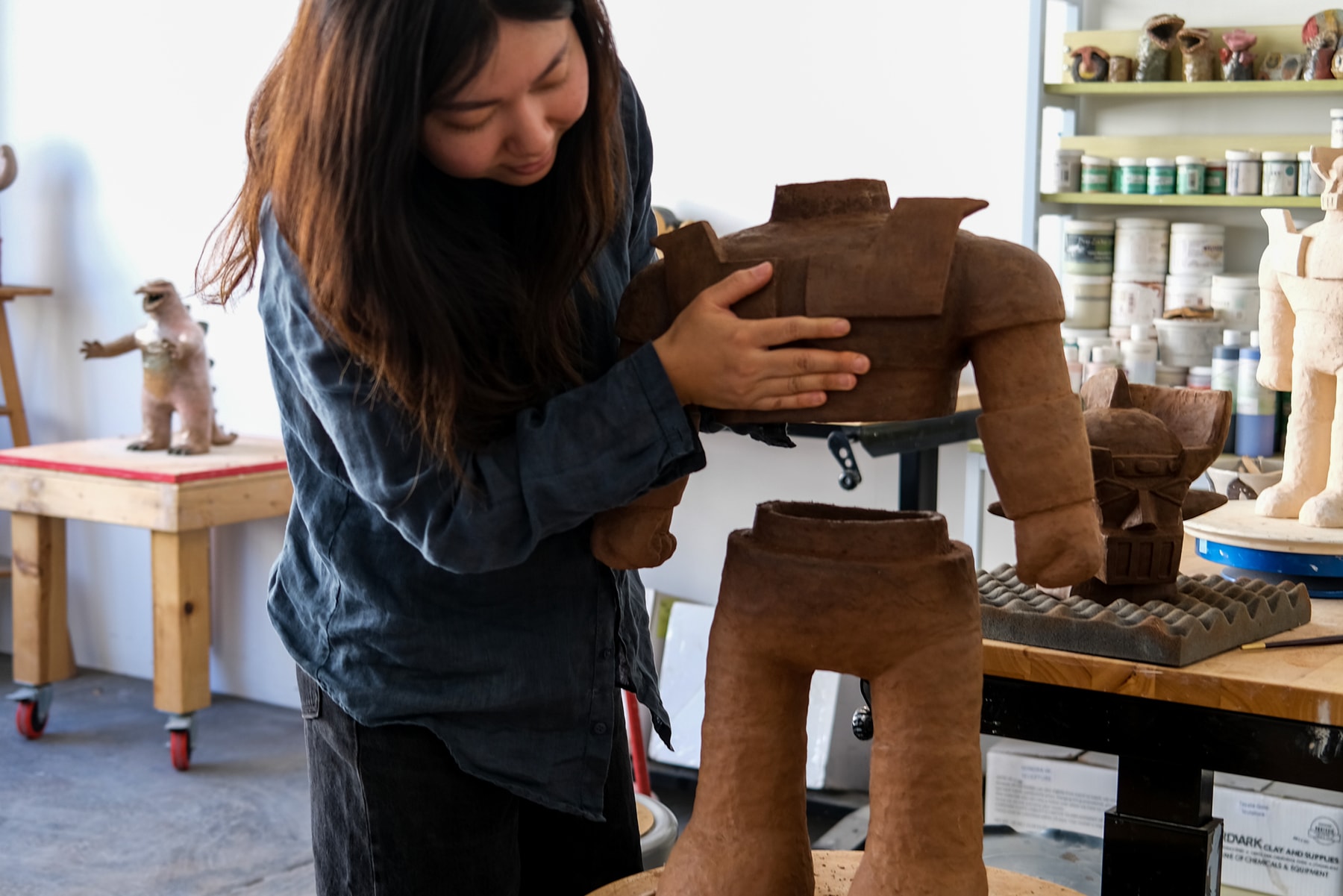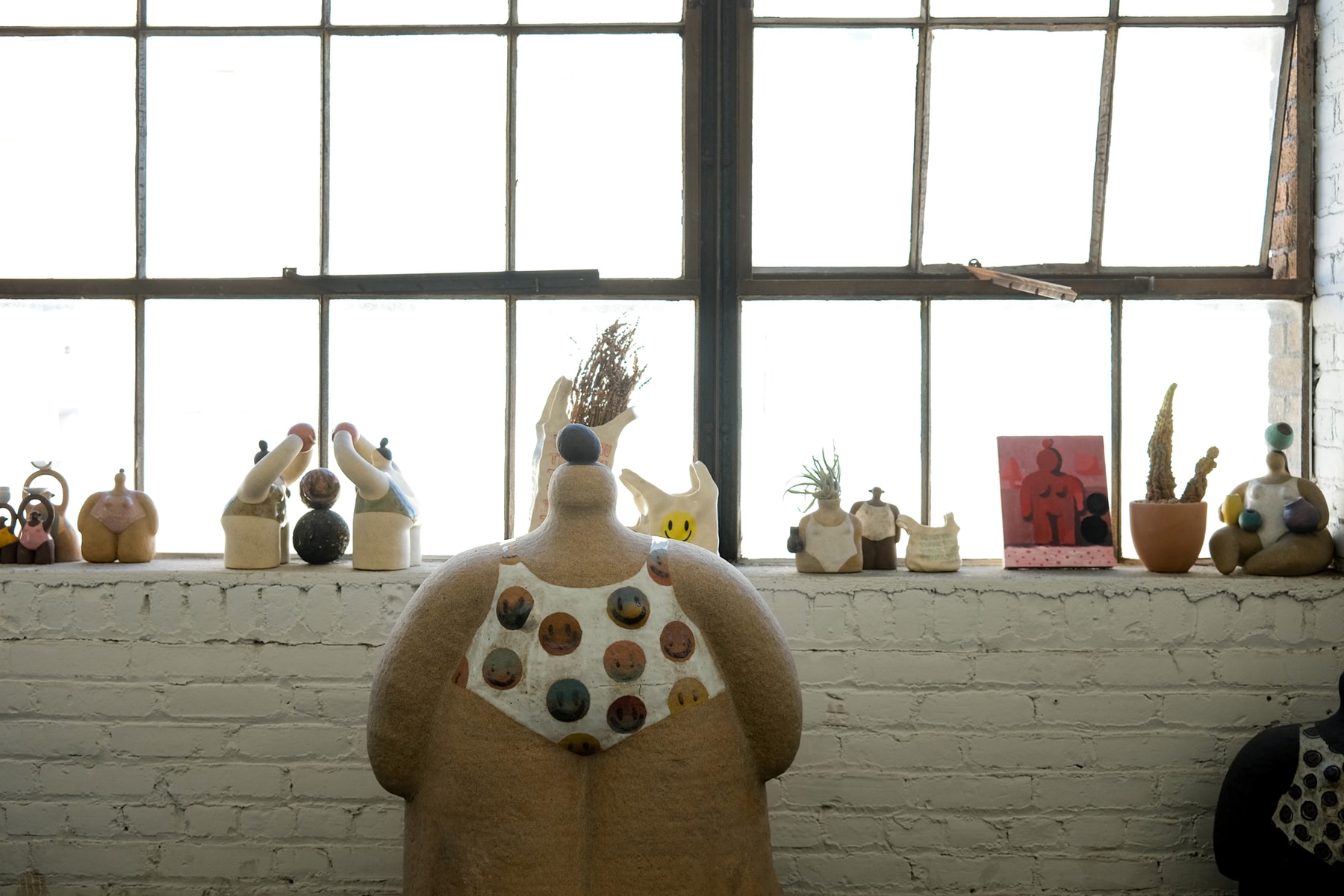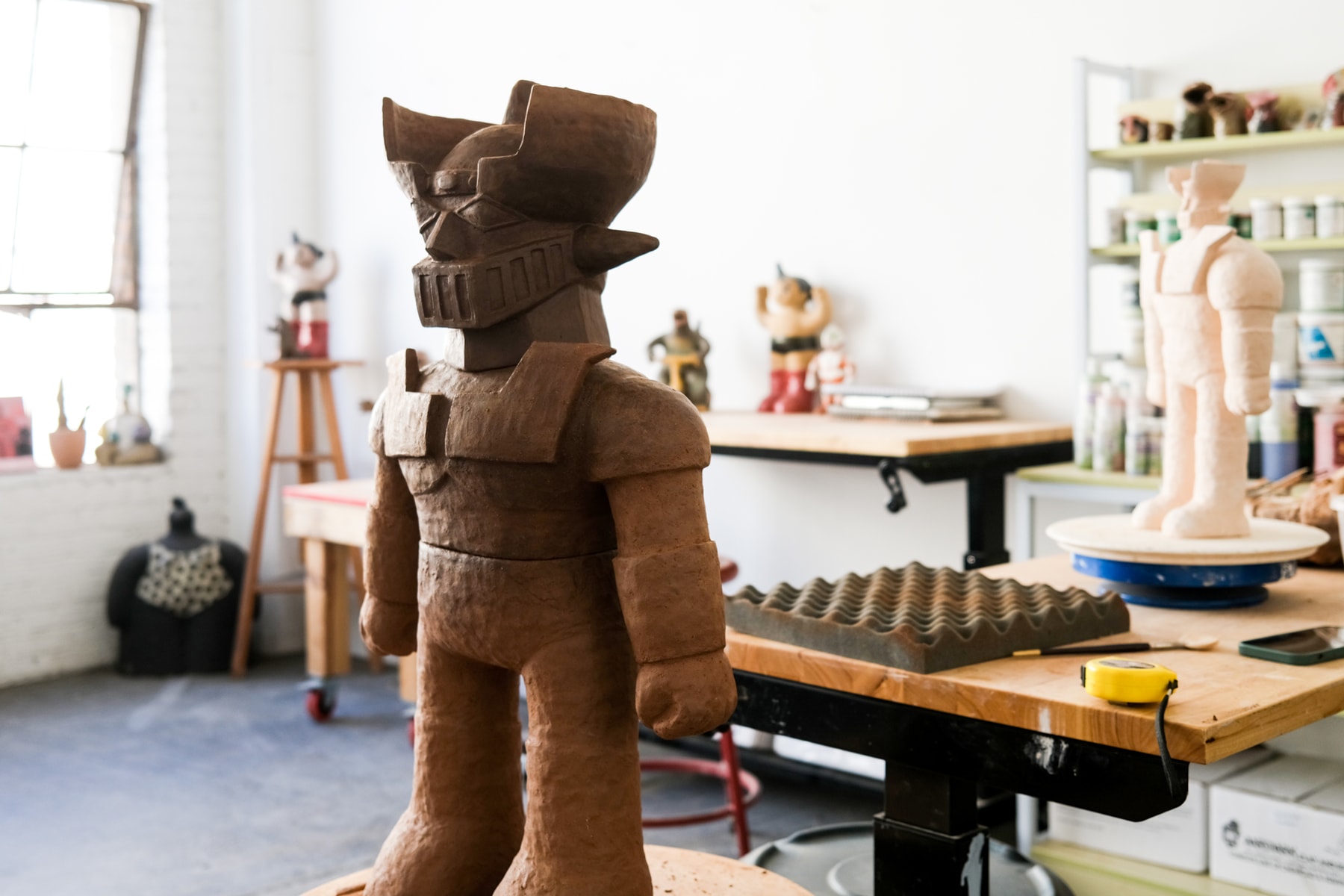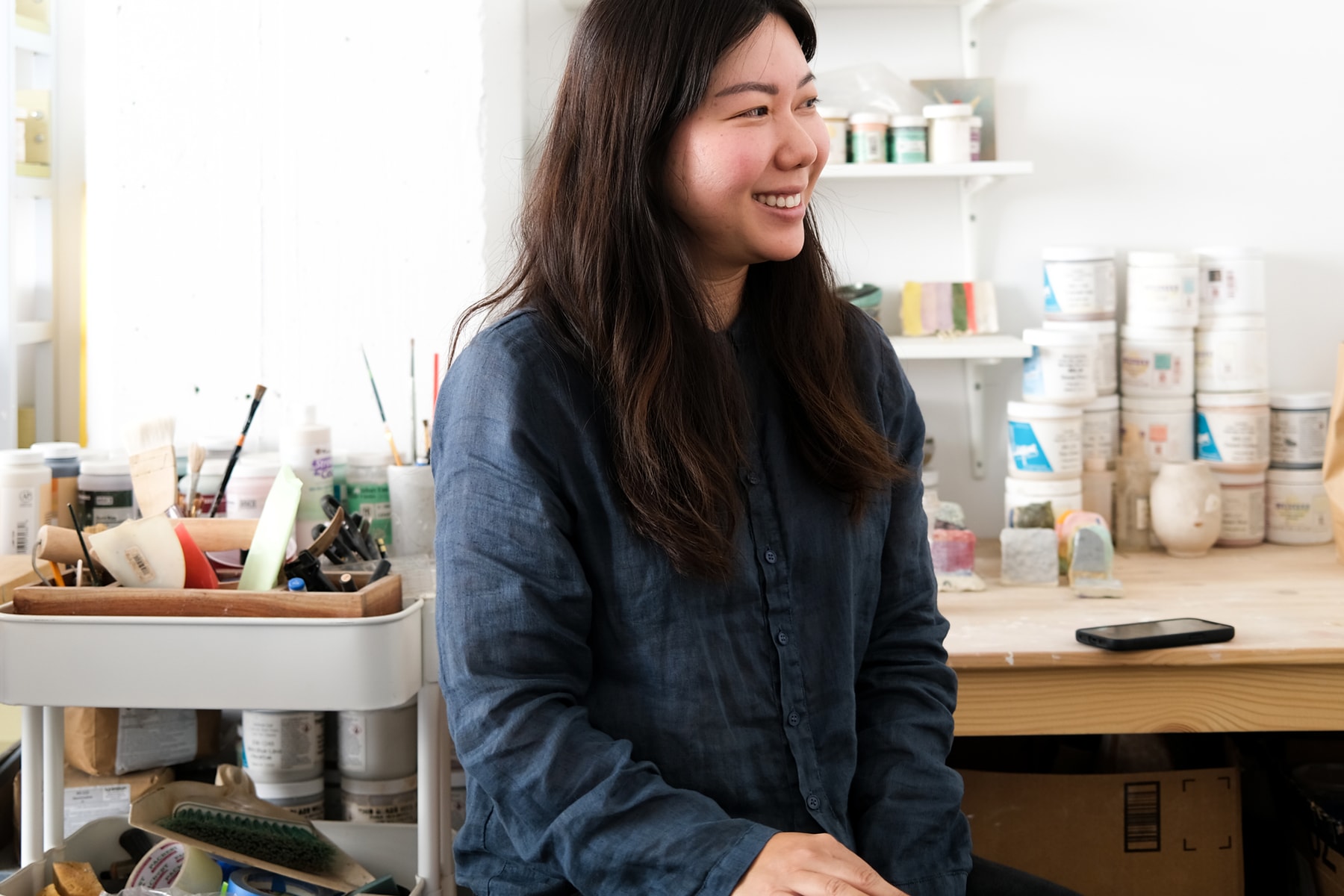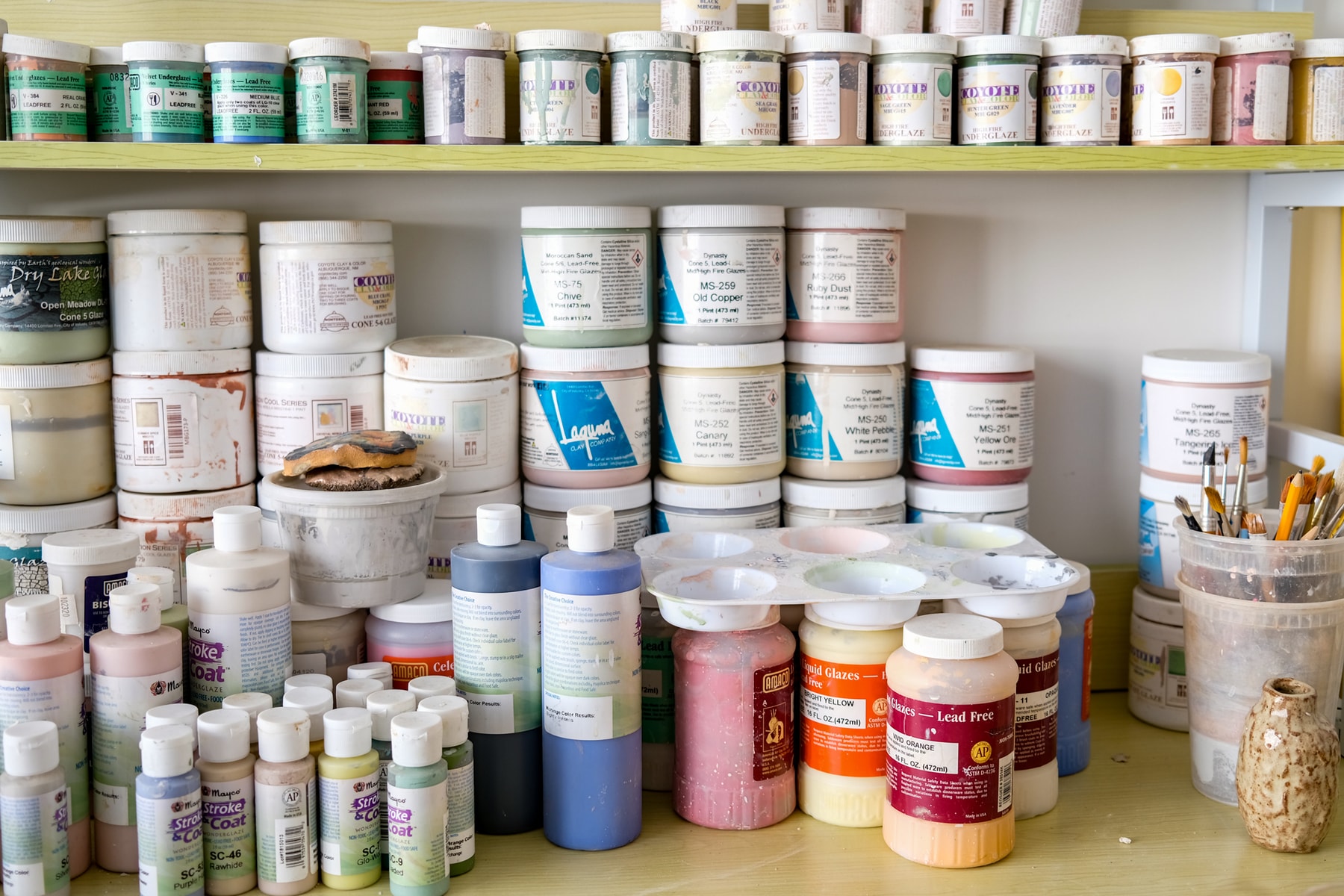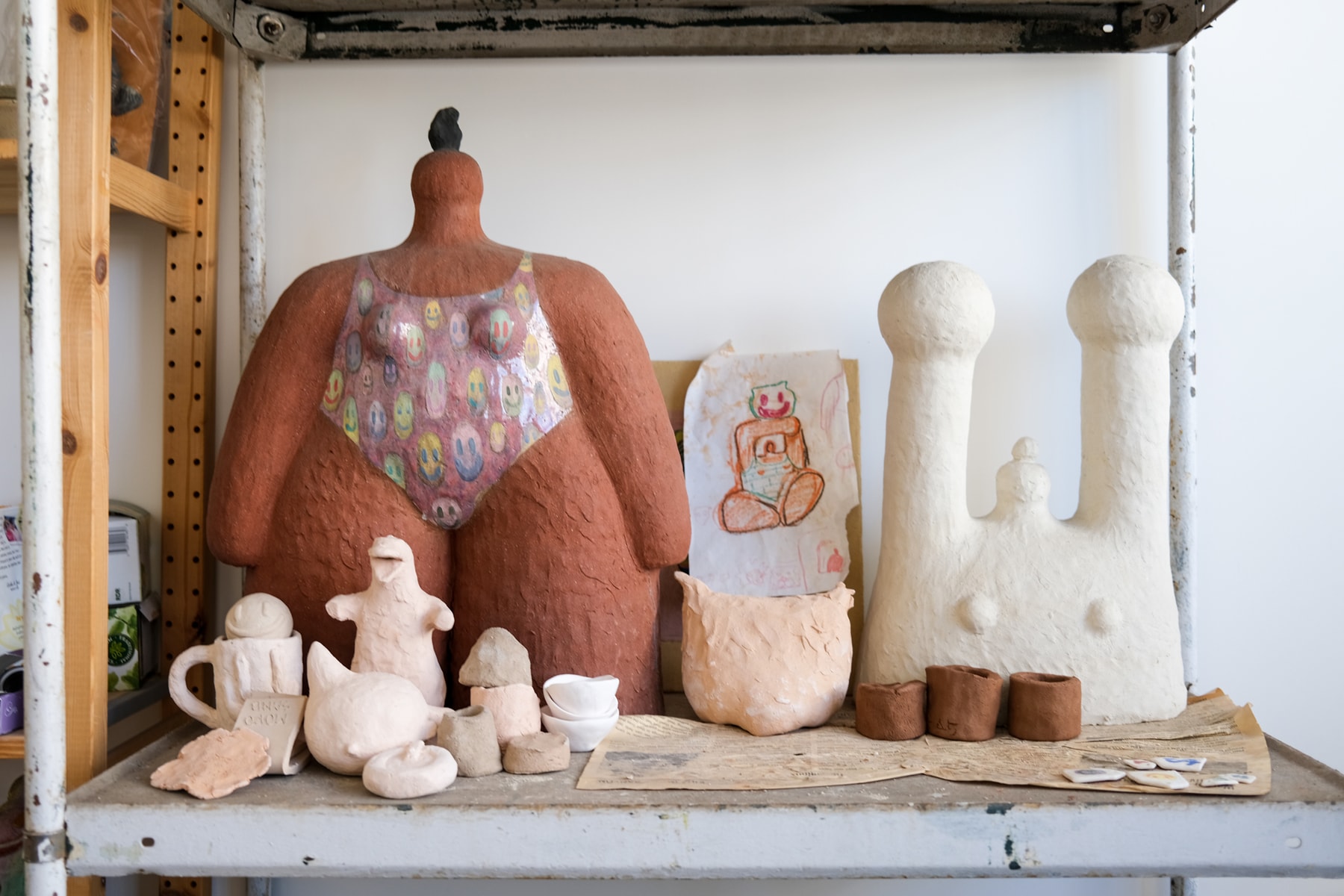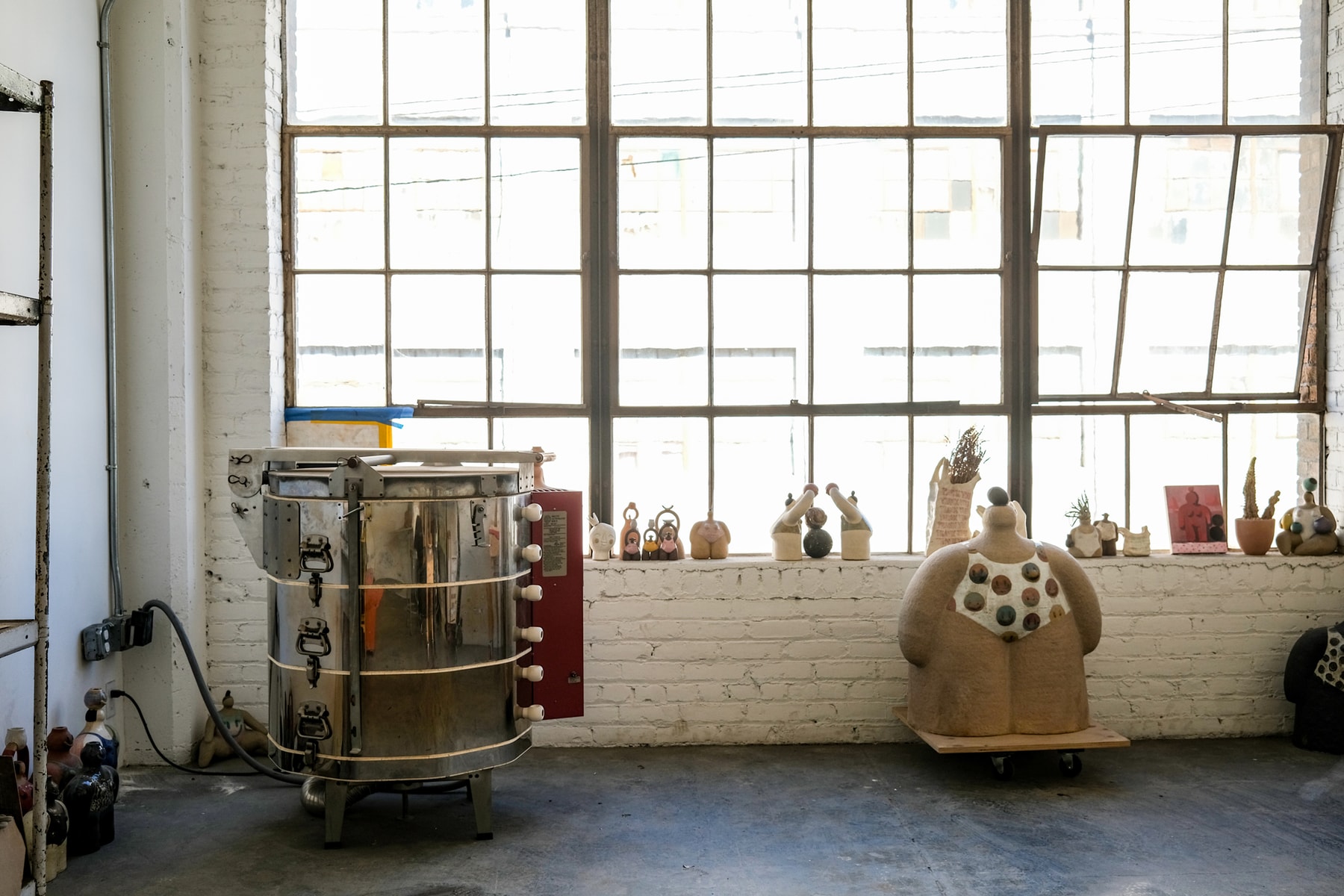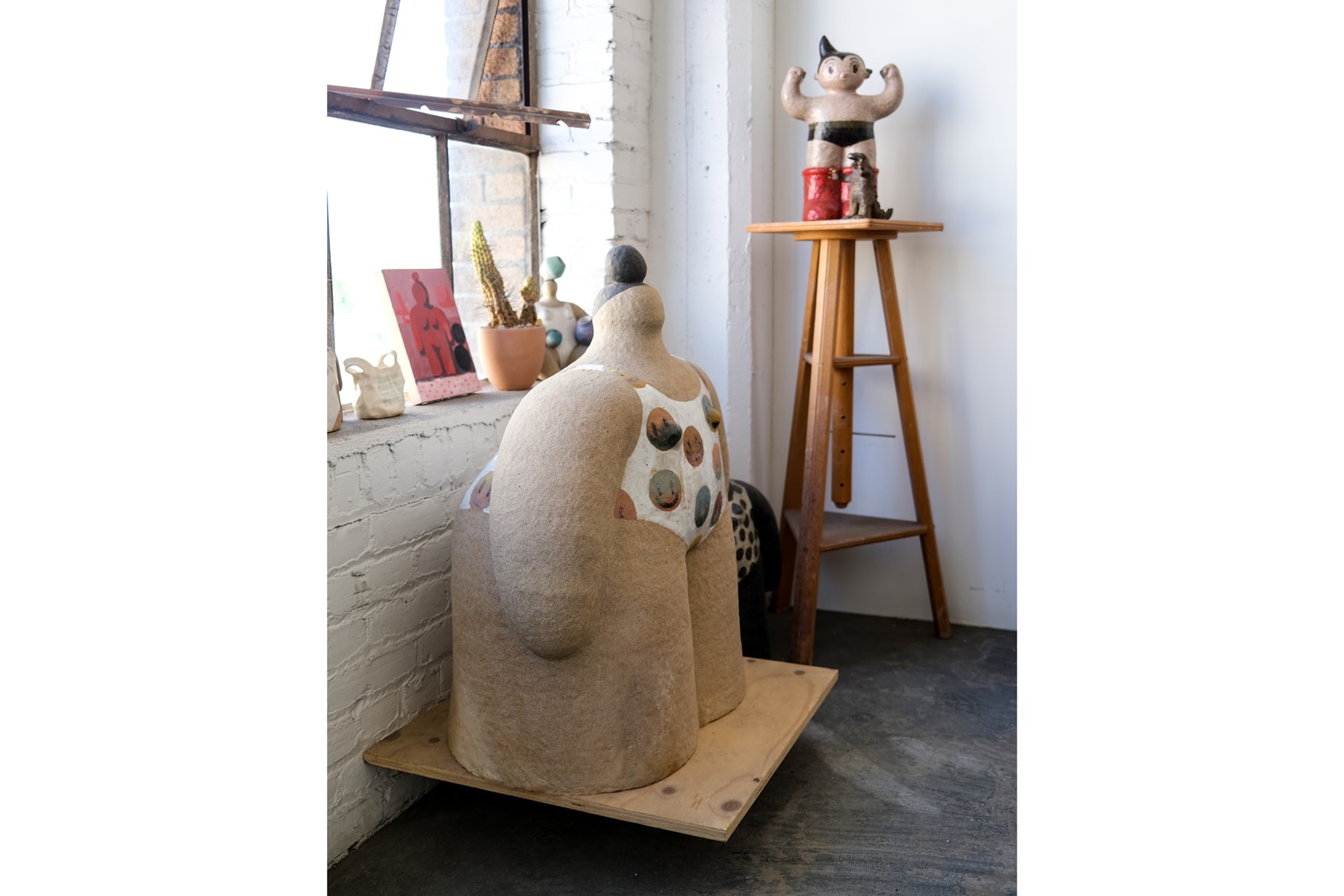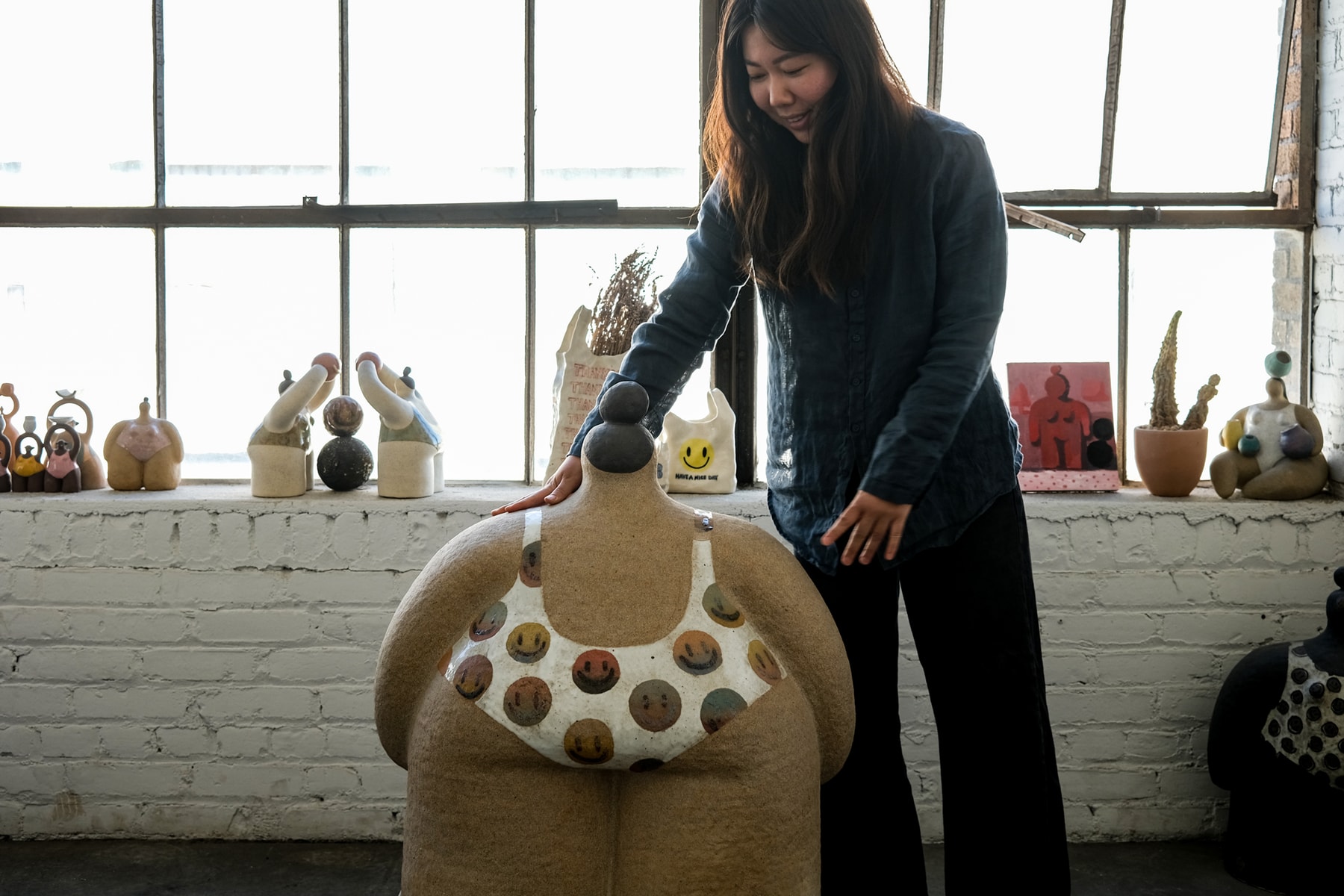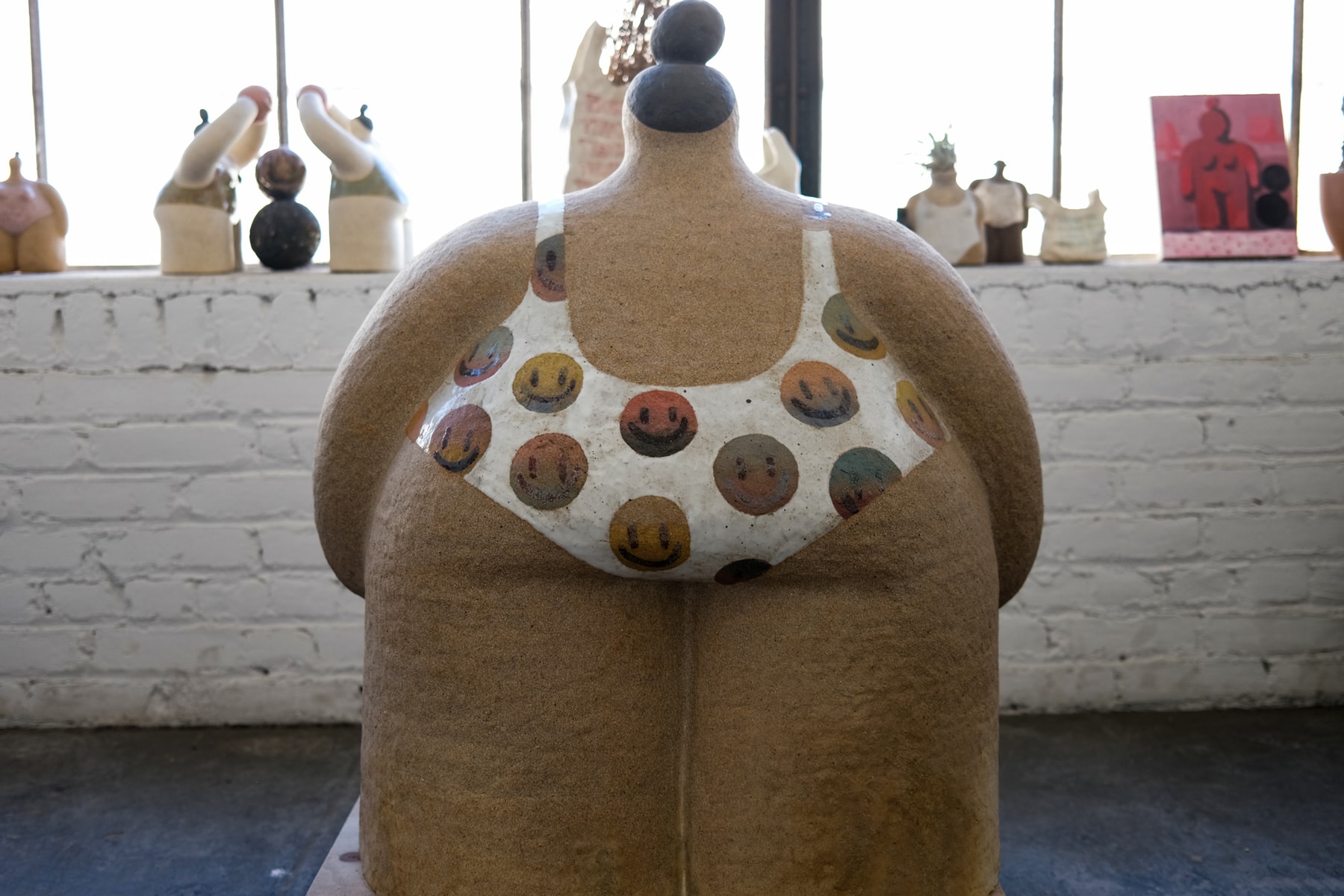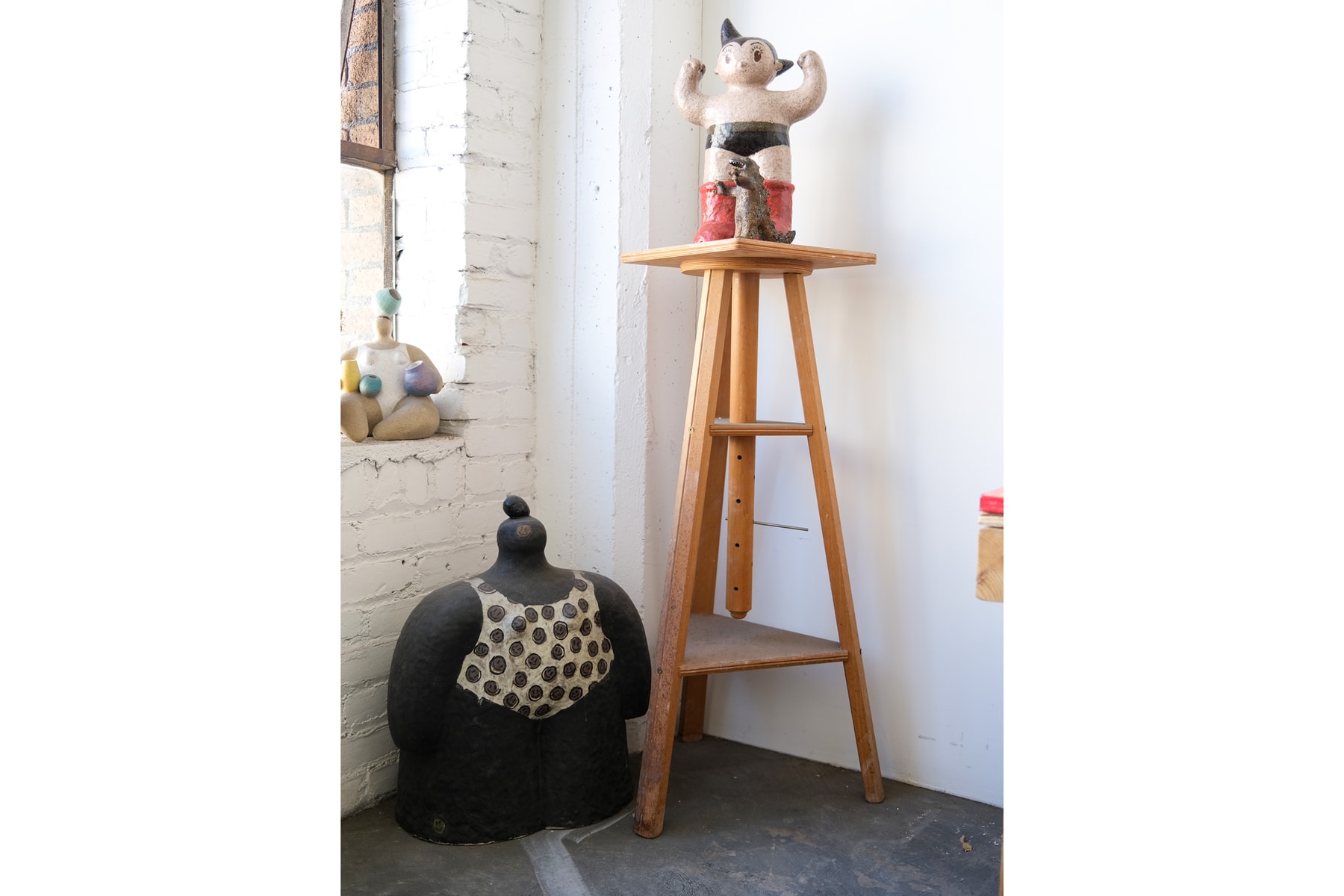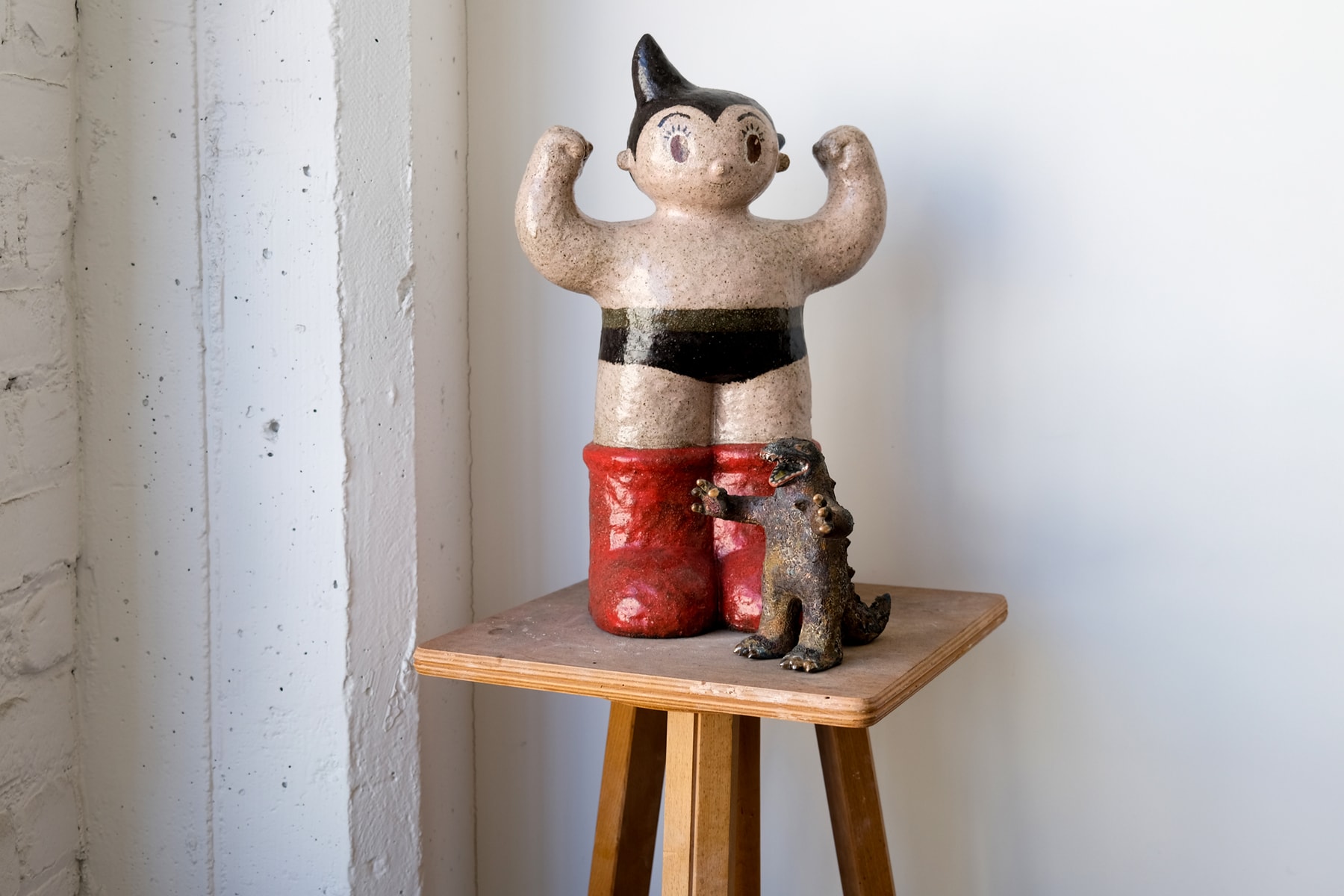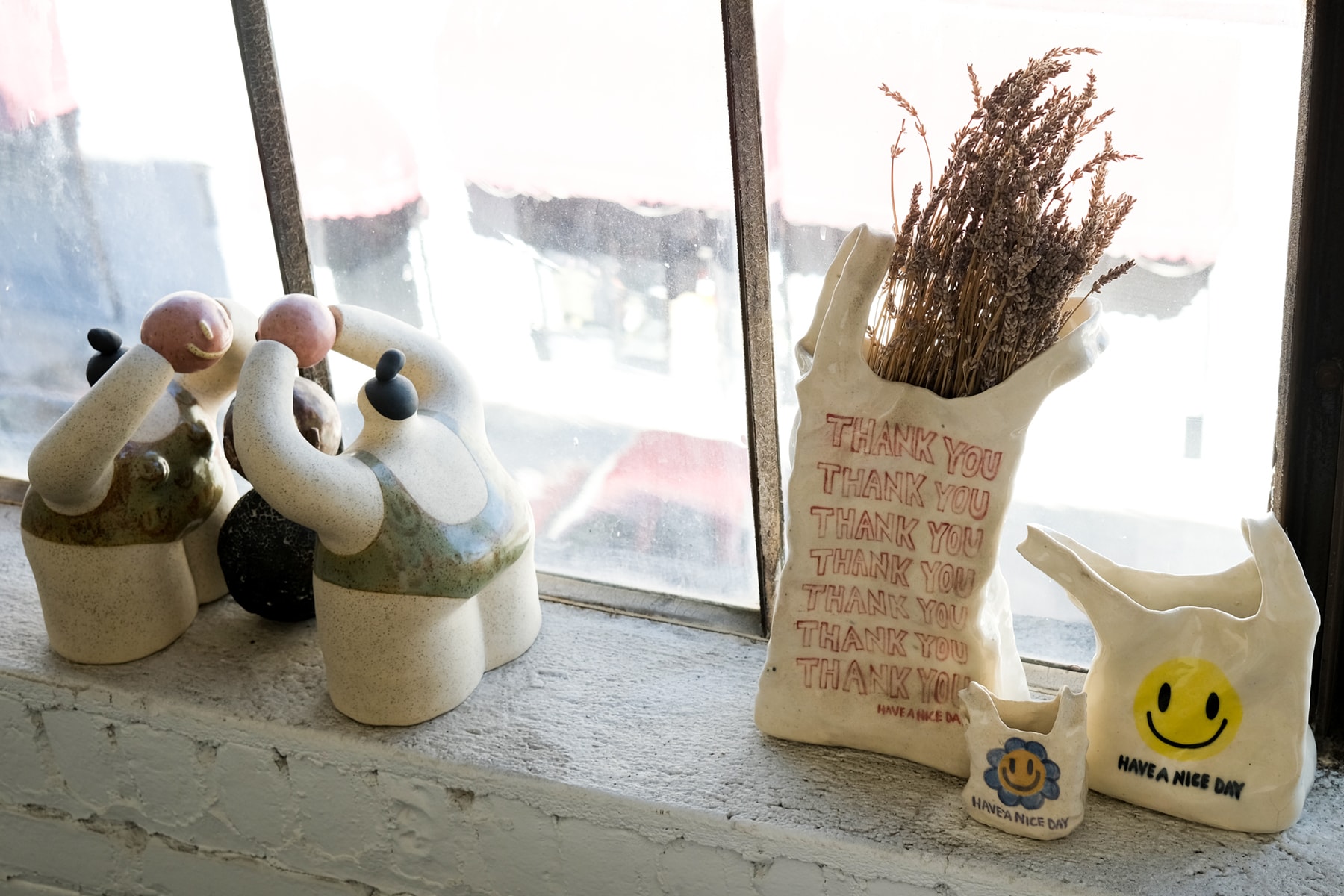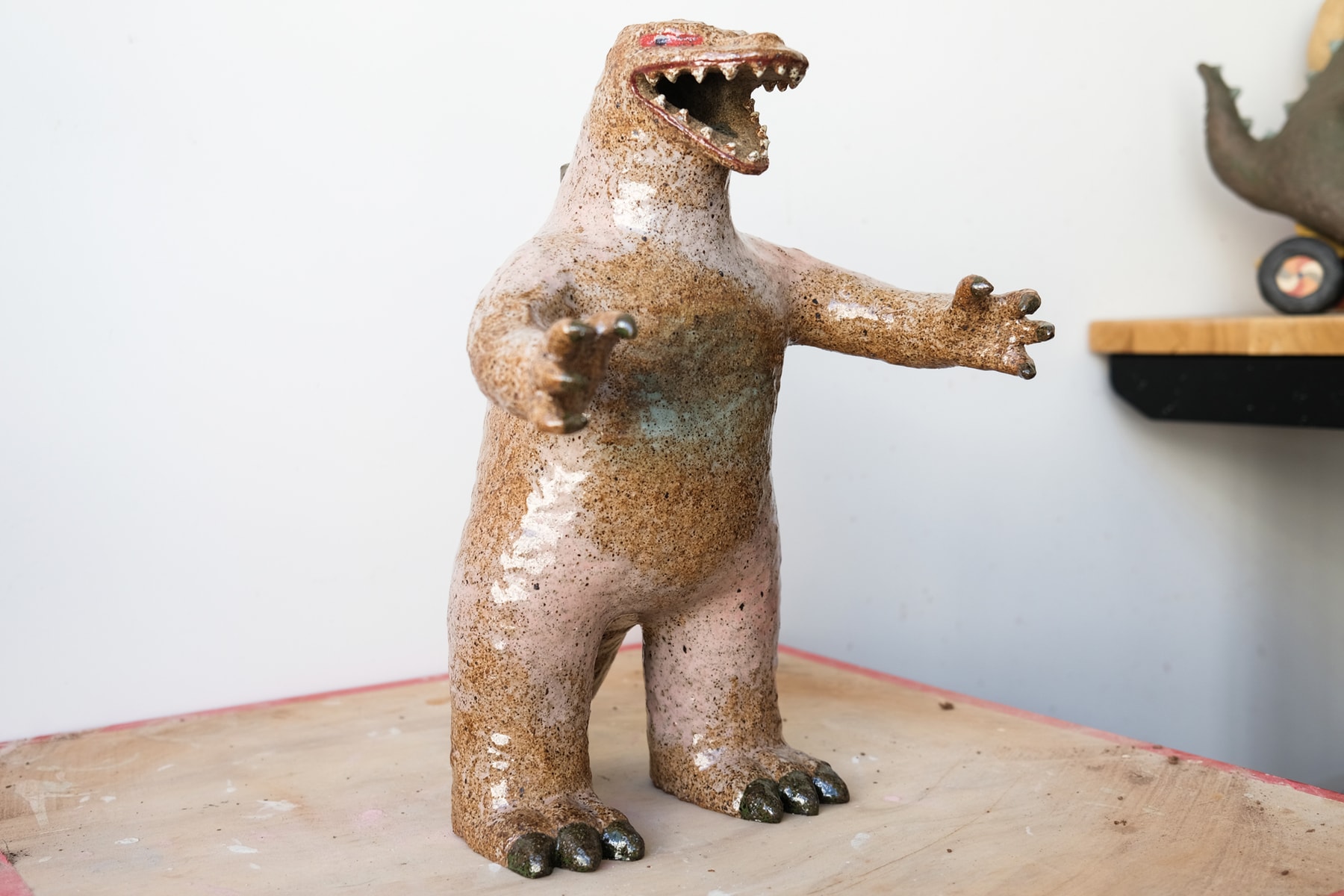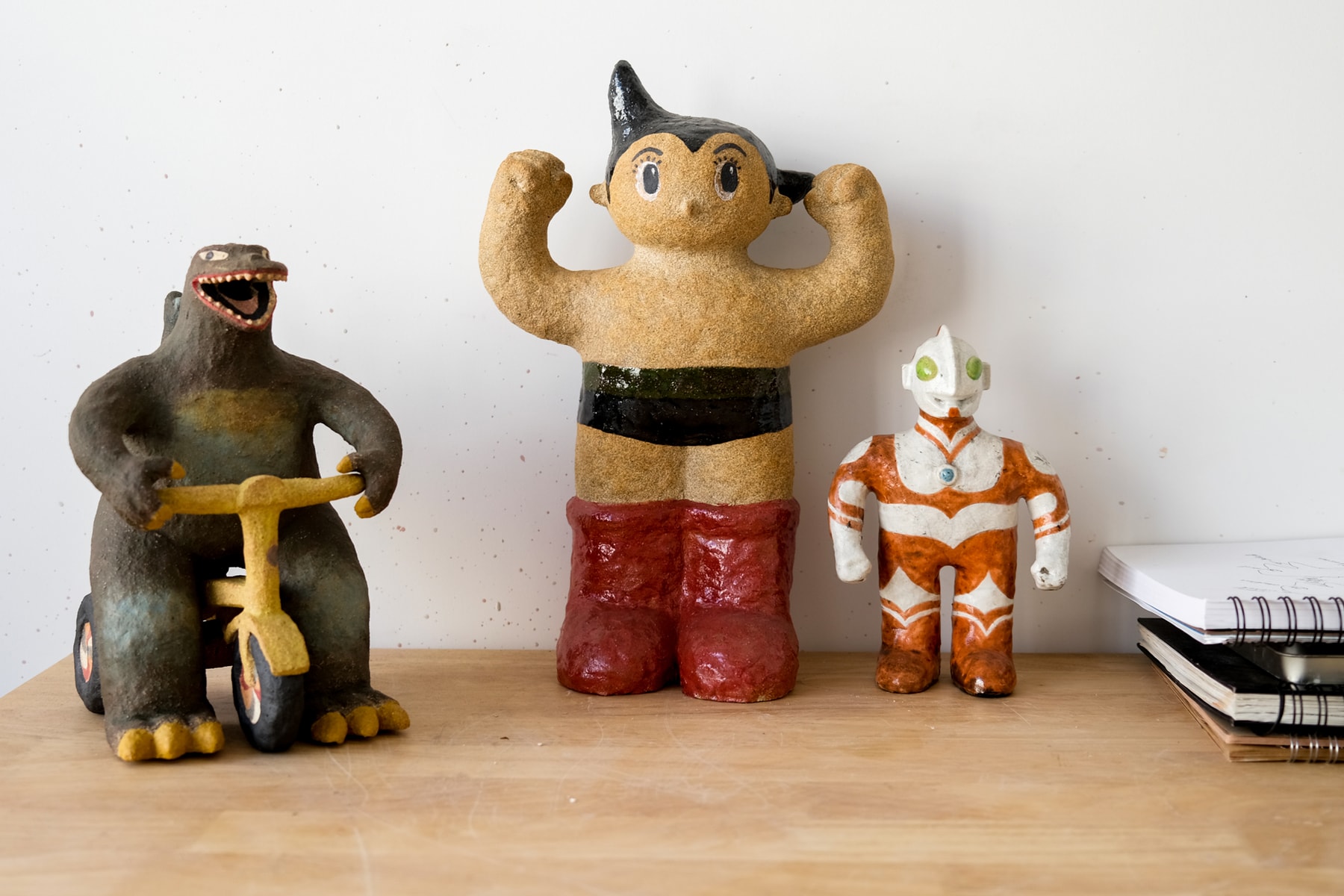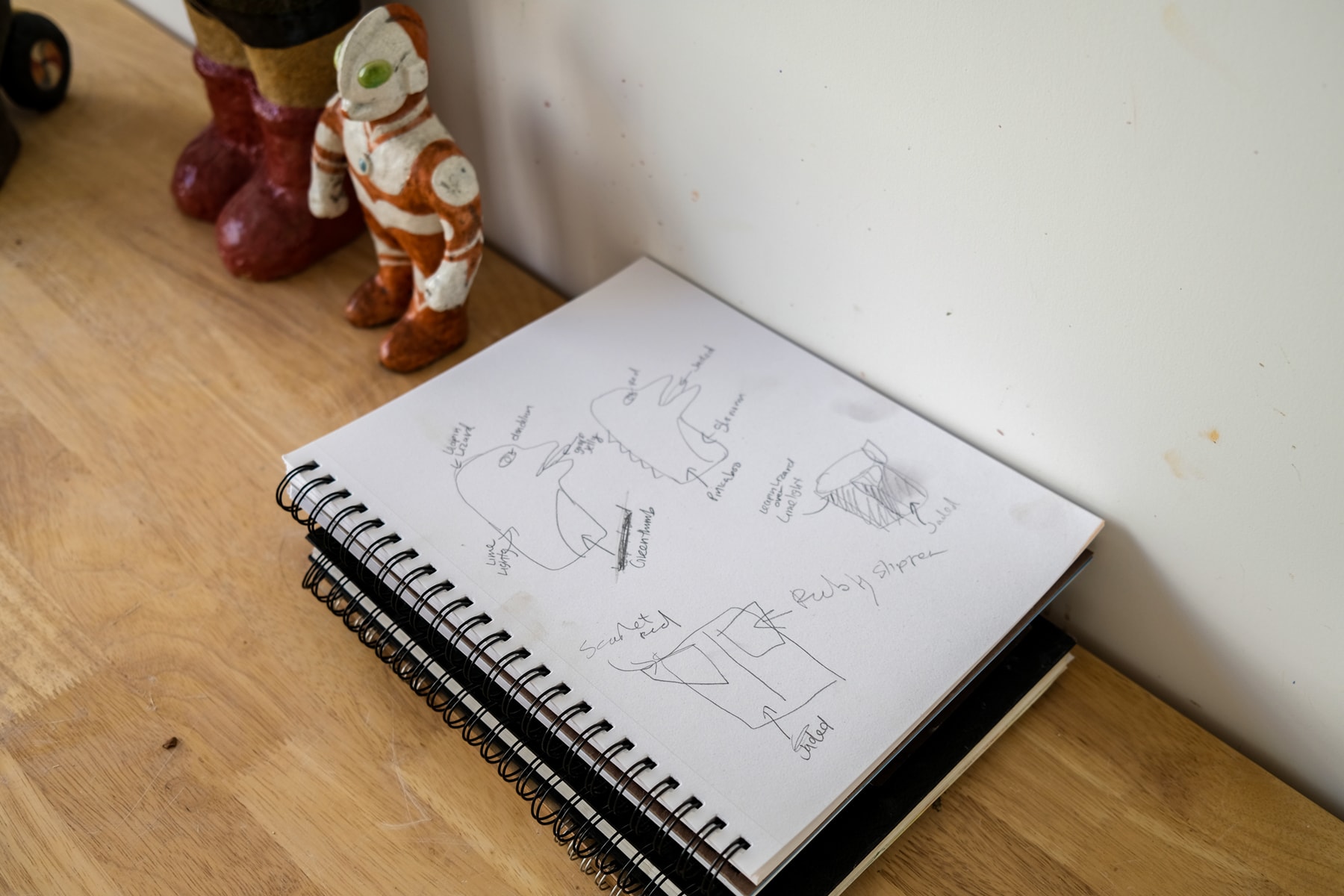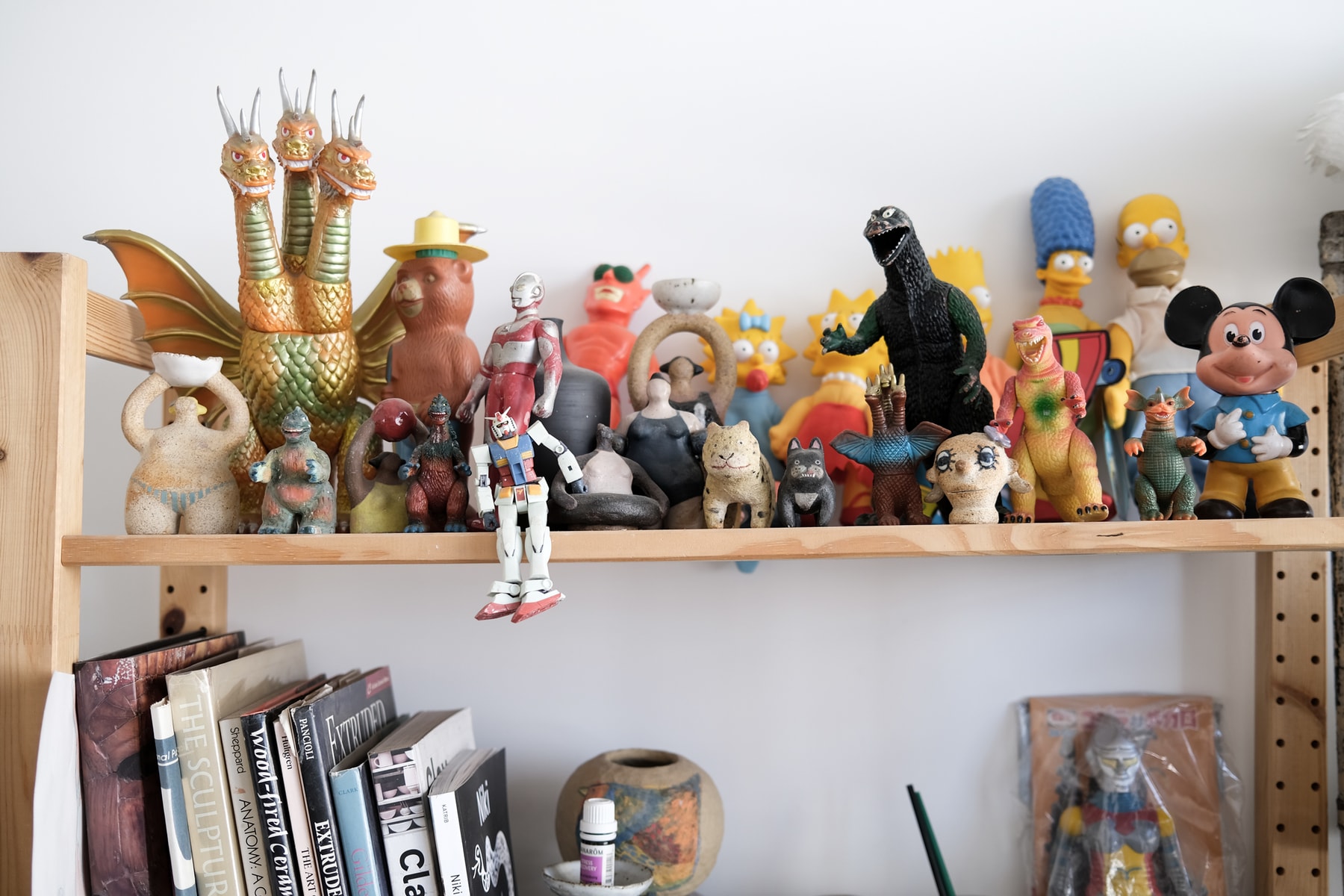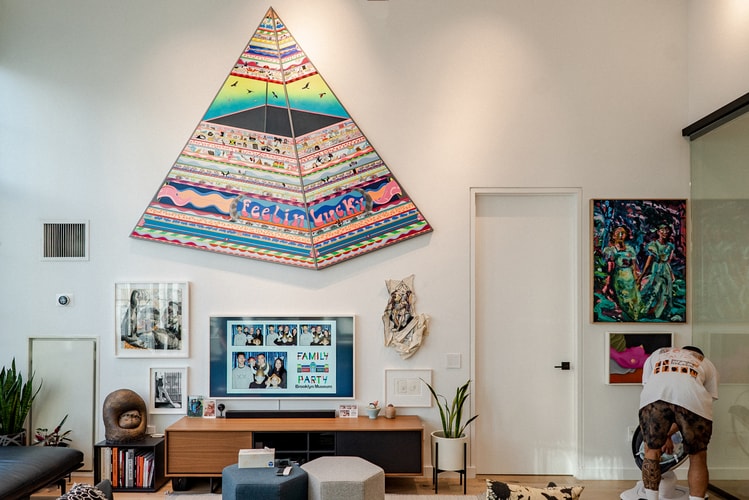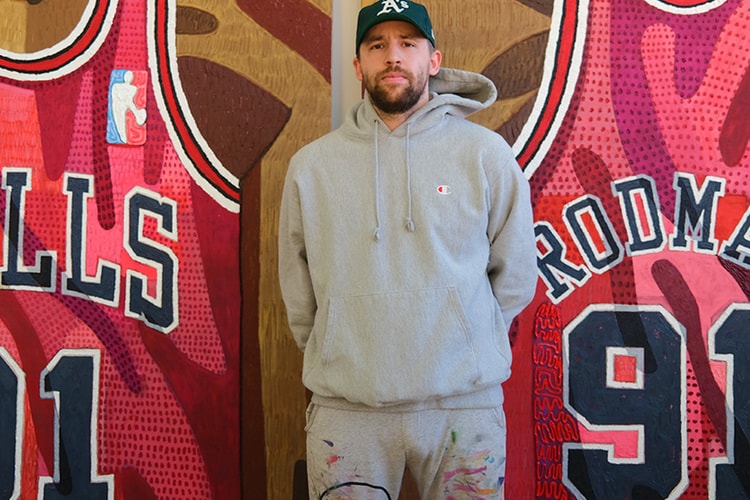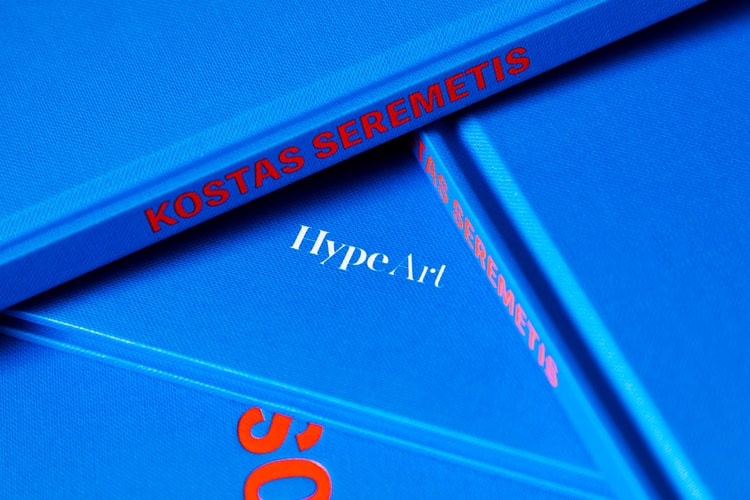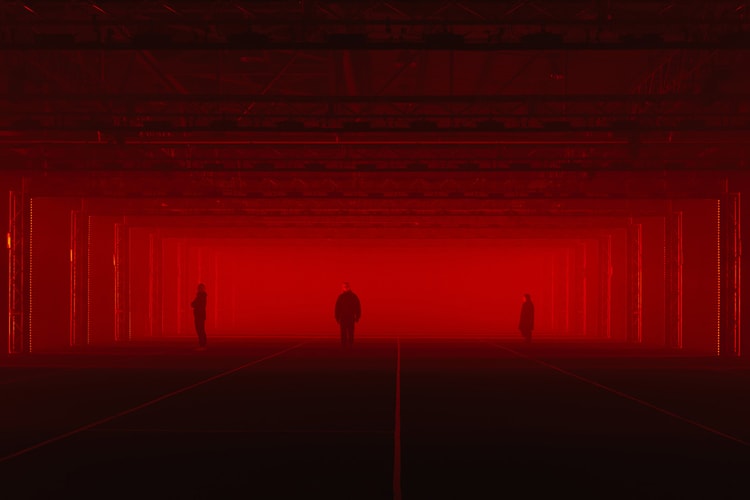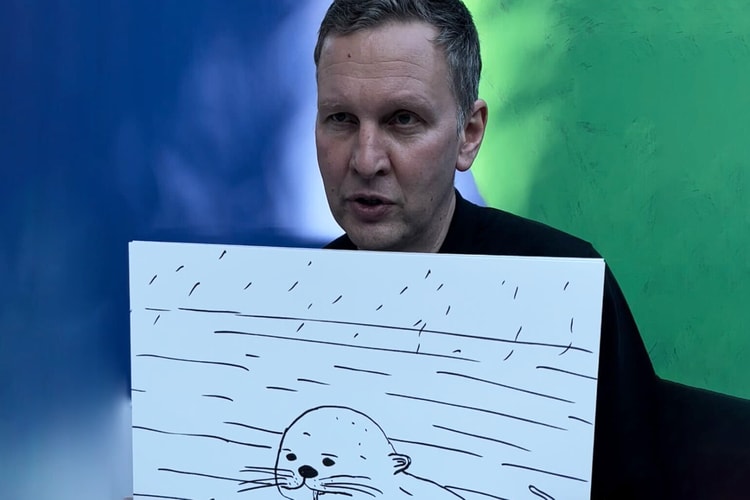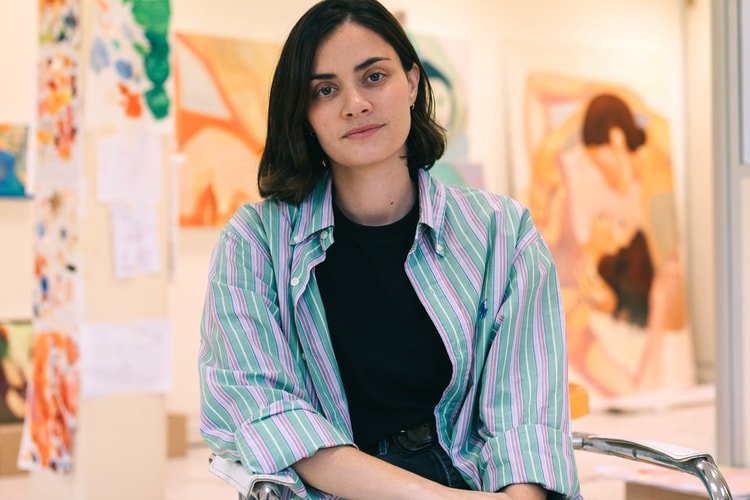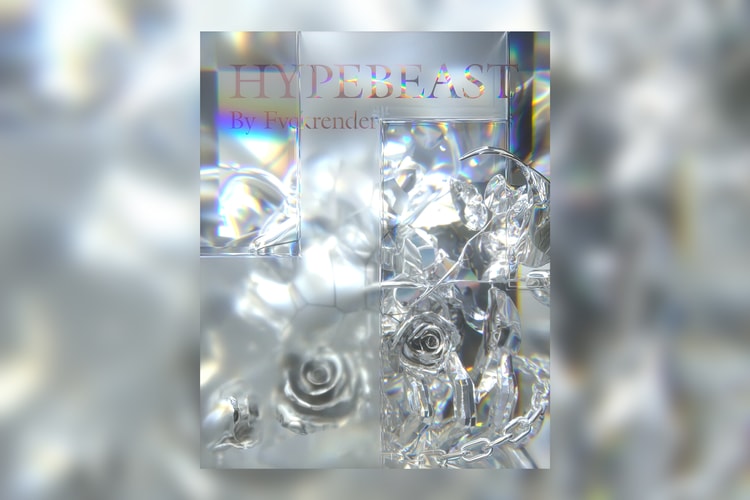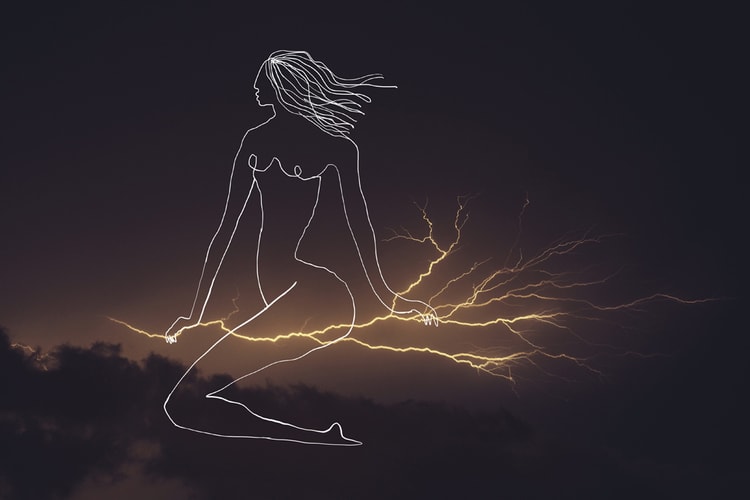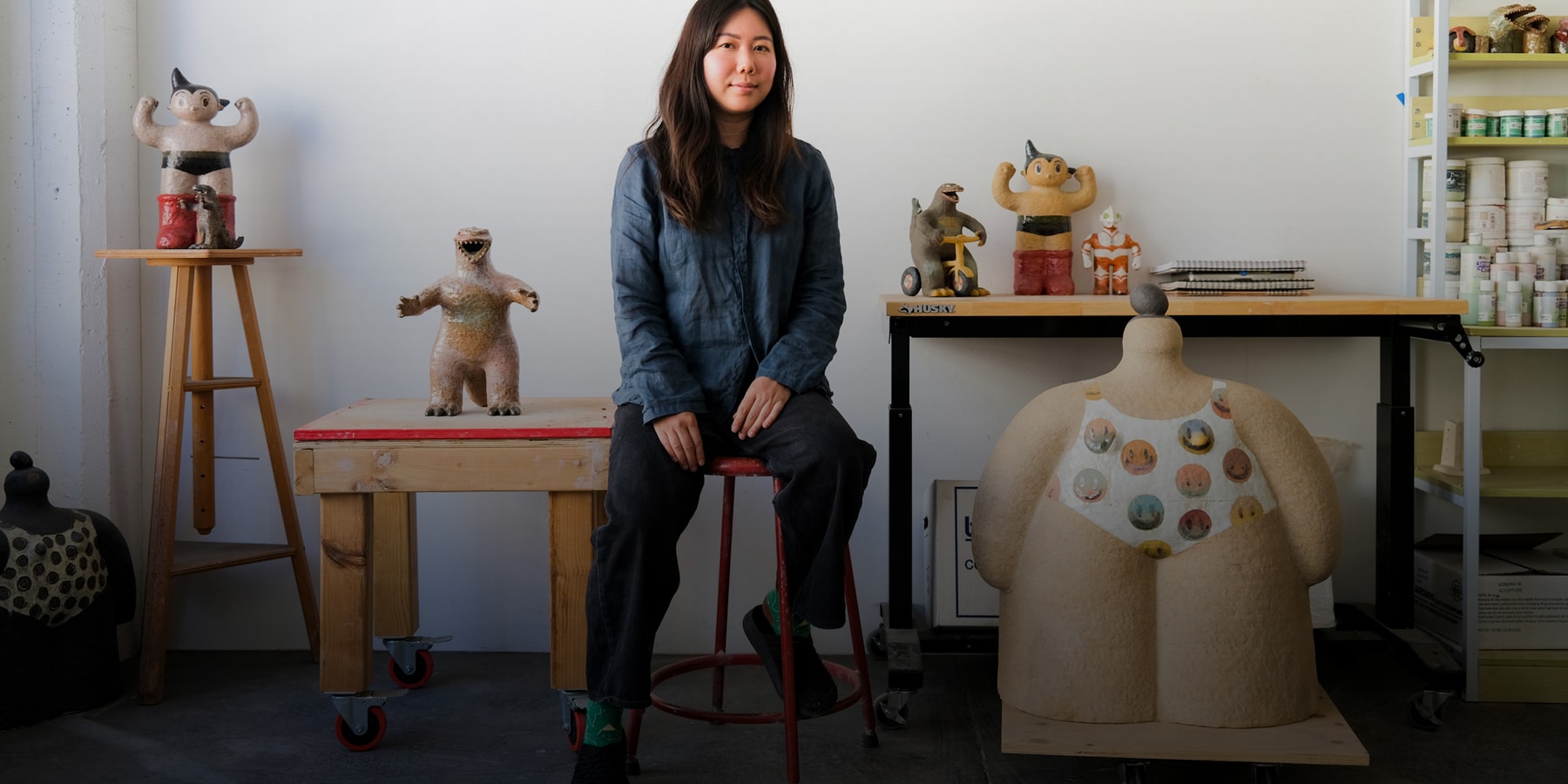
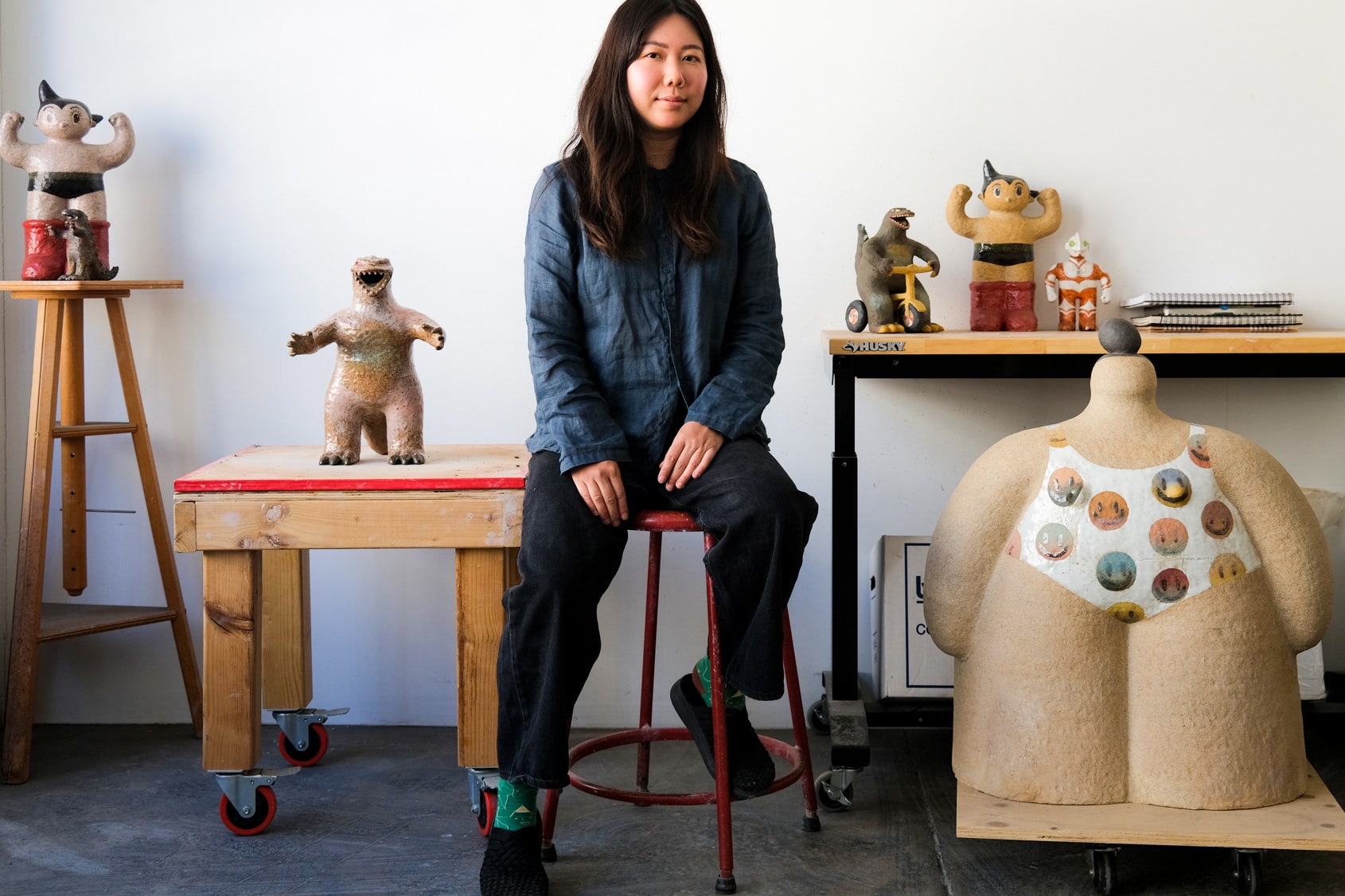
Tucked in the heart of Los Angeles’ fashion district is a small warehouse that serves as a haven for artists to create artworks of various mediums. One of these artists is the Korean-American ceramicist, Taylor Lee, who is known for her three-dimensional reimaginings of vintage Japanese toys. From the ’60s-era Kyodai Heroes like Ultraman who are able to grow to immense heights and fight giant monsters like Godzilla to the cult-manga protagonist Astro Boy who dominated animated Japanese television, Taylor’s inspirations for her current work draw heavily from live action dramas of superhumans and robots based in Japan or the Tokusatsu genre — films that make heavy use of special effects.
Inside her naturally-lit studio is a cast of ceramic figurines ranging from miniature to large-scale that portray the aforementioned characters. Before creating a ceramic work, Taylor first decides which figure she wants to create and then she “eye-balls it” when it comes to the clay-building portion of her process. She starts the build at the bottom of the form and adds tube-like structures of clay on top of each other to her preferred height. Once she’s satisfied with the construction, she glazes it with her own ingredients and then places it inside a kiln to get the form fired up, hardened and transformed into a ceramic sculpture.
Most of the time, she uses the standard electric kiln to create sculptures, and other times, she spearheads a Raku firing process for a unique finish on the form. Raku firing is an ancient Japanese ceramics technique that has been used for many centuries to create an unpredictable effect on objects. Raku firing creates unique pieces as there is never a certainty as to how the final piece will turn out – it’s a one of one design every time, so there is less control on the outcome.
Taylor was born and raised in the city of Henderson in Nevada. She attended the University of Nevada, Las Vegas to pursue a degree in art and it is where she found her love for ceramics. Since then, she has realized various ceramic creations in her practice including abstracted forms of female figures that recall historical idols alongside creatures and superheroes from Japanese pop culture. Recently, Taylor and her husband, Peter Chan, launched a duo exhibition of original works called “Toy Show” at Over The Influence in Hong Kong. For the show, Lee presented Raku-fired ceramics of Gundam Wing, Godzilla, Astro Boy, Ultraman, among others. On the walls, Peter mounted abstract paintings that explored childhood nostalgia including reinterpreted versions of Gundam Wing in a vibrant pastiche. Other references include the pair’s interests across toys, comics and entertainment.
At Taylor’s studio, we found time to discuss her practice, inspirations and passion for ceramics. Check out the exclusive interview below as part of our Studio Visits series.
“I had this revelation in 2017 when I just quit everything and focused on making ceramics.”
When did you move into this studio?
I moved in the middle of 2020 when COVID-19 hit, and no one was renting out anything. It was around May or June when everything was shut down. I needed this studio to create works for a show in January and wanted a more private space with a kiln. This space was renovated at that time and they were prepared to rent it out fast, but no one was looking for spaces. So I got a pretty good deal here.
Where were you making art before?
I was creating work in my house at Topanga Canyon on the westside of LA. The area was a really pretty place up in the mountains and the cabin, but it wasn’t my ideal place to make ceramics. There were a lot of things that I had to take care of in the house and we’re surrounded by plenty of nature without any concrete floors. My husband, Peter Chan, who is also an artist needed space to create so it was a pretty tight space for both of us to make work.
When did you first get into ceramics and why did you want to pursue this medium?
I have been doing ceramics since I attended the University of Nevada, Las Vegas. I actually grew up in a city called Henderson in Nevada which was like 20 minutes away from the strip. It’s a small town, the suburbs pretty much. When I studied art, there was a lot of freedom and access to studios. When I think about it now, I should have taken more advantage of it, haha. After I graduated, I stepped away from doing art because I just started working in high end retail. And then I went to LA, I went to Santa Monica College to study fashion and try to build a career in that world. I started buying downtown and absolutely hated it. At one point, my husband encouraged me to take up ceramics again, but I never thought I could do it full time. I had this revelation in 2017 when I just quit everything and focused on making ceramics.
“I find early examples of human sculptures to be astonishing.”
What made you want to flip that switch?
I tried so many different things in my life, but I always came back to doing some sort of ceramics. I fell in love with ceramics in art school and wanted to get back to doing it. I didn’t like to paint too much or draw a lot, but for ceramics, I was making it all the time.
Is it something about the material that draws you into it?
Making ceramics is definitely therapeutic in a way especially when it comes to freely building it by hand. I’m not actually good on the wheel or any of the conventional stuff. What’s funny is the school I went to in Vegas, the ceramics department teacher hated the idea of ceramics being crafty. He emphasized that ceramics were part of sculpture, instead. So he didn’t teach anybody the wheel. He didn’t want ceramics to be associated with pottery. I wish I learned it though because there’s so many other skills I can apply to my artwork.
What kind of ceramic forms were you making earlier on?
When I started becoming very serious with it, the first thing that I wanted to create were these minimalist women figurines but make them look historical as if they were discovered in an archaeological site and put in a museum. I find early examples of human sculptures to be astonishing, especially how modern their forms look. I also appreciate the idolization of the female body back then that wasn’t focused on a woman being too skinny or tall. Instead, they were voluminous and exaggerated which I find to be very beautiful. These sculptures were tied to themes of fertility, birth and spiritual worship. I wanted to channel this idea into my sculptures of women earlier in my career.
Also when you see the sculptures of women that I made here, some of them have these repetitive happy face motifs. During the pandemic, I had a lot of anxiety especially when it came to watching the news or looking at social media stories. Making these happy faces made me happy and so it became a therapeutic thing for me to do.
“I let myself create these figurines without any thought and see where it goes.”
Is there a reason why your sculptures of women don’t have any faces?
I just thought the faces would be distracting and want people to focus on the form. Also, I like the minimalist aspect of it and how it ties back to historical examples. These women figurines are actually a lot harder for me to create then the Japanese toy reinterpretations. It’s more of a conceptual approach and I have to put a lot of thought into why I’m doing it. I let myself create these figurines without any thought and see where it goes.
Why did you transition into making Japanese toys?
It was almost like a mental break for me. They’re fun to make, made me happy to create them and also the nostalgia factor. I like having this balance where it’s more conceptual and hard-thinking to create the female forms, but easy and relaxed when it comes to creating the Japanese toys.
Do you have a go-to clay and firing method that you use?
I have so many different clays that I use. I try to use a lot of sculpture clay, especially dark clay, which is more of that groggy or steadier kind that is easier to build larger forms. I also do a lot of different firings. I do electric which is the one I have here that is very precise, stable and predictable when it comes to the outcome of the sculpture. It’s also good to use if you want bright colors. And then sometimes I use the gas kiln which fires clay with actual gas, fire, oxygen and reduction. With this method, you don’t exactly know what the form is going to look like. I like using this method too because the sculpture looks less commercial to me. If I could choose, I would just do gas all the time.
“Making these works make me happy, so that’s what I’m trying to achieve.”
Tell us more about your interest in comics.
I grew up in Henderson so there were not a lot of Asians or Asian culture there. Instead, my parents would give me a bunch of Japanese comic books. I used to think these comics were Korean, but they were only translated in Korean. I’ve learned a lot about manga and Japanese culture through these comics. I also love Dragon Ball. When Korean people made it, it was terrible. I used to buy VHS tapes of anime in like the only Asian store in the neighborhood. This Asian seclusion of where I grew up only quenched my thirst for Asian pop culture when I was young. I had to walk through the middle of the desert in Vegas just to get to that Asian goods store.
My husband, Peter, actually taught me about the Japanese superheroes like Ultraman and Astro Boy as well as those Guzo figures since I wasn’t aware of them. He’s a great collector of novelty toys and I like using them for my own inspiration to create ceramics.
Do you have any mentors in ceramics?
I was a studio assistant for this Venezuelan artist named Magdalena Frimkess. She creates hand-painted, rather than dipped, glazed ceramics which feature subjects from mythological motifs to pop characters. She was eye-balling her forms too and used a gas kiln to create her work. She would always get this unpredictable look to her ceramics, which I liked and thought was really cool.
She’s definitely one of the reasons why I’m making ceramics full-time. She’s about 90-years-old right now and still creating work. She made me realize that making ceramics could be a part of something I do all the time even after retirement.
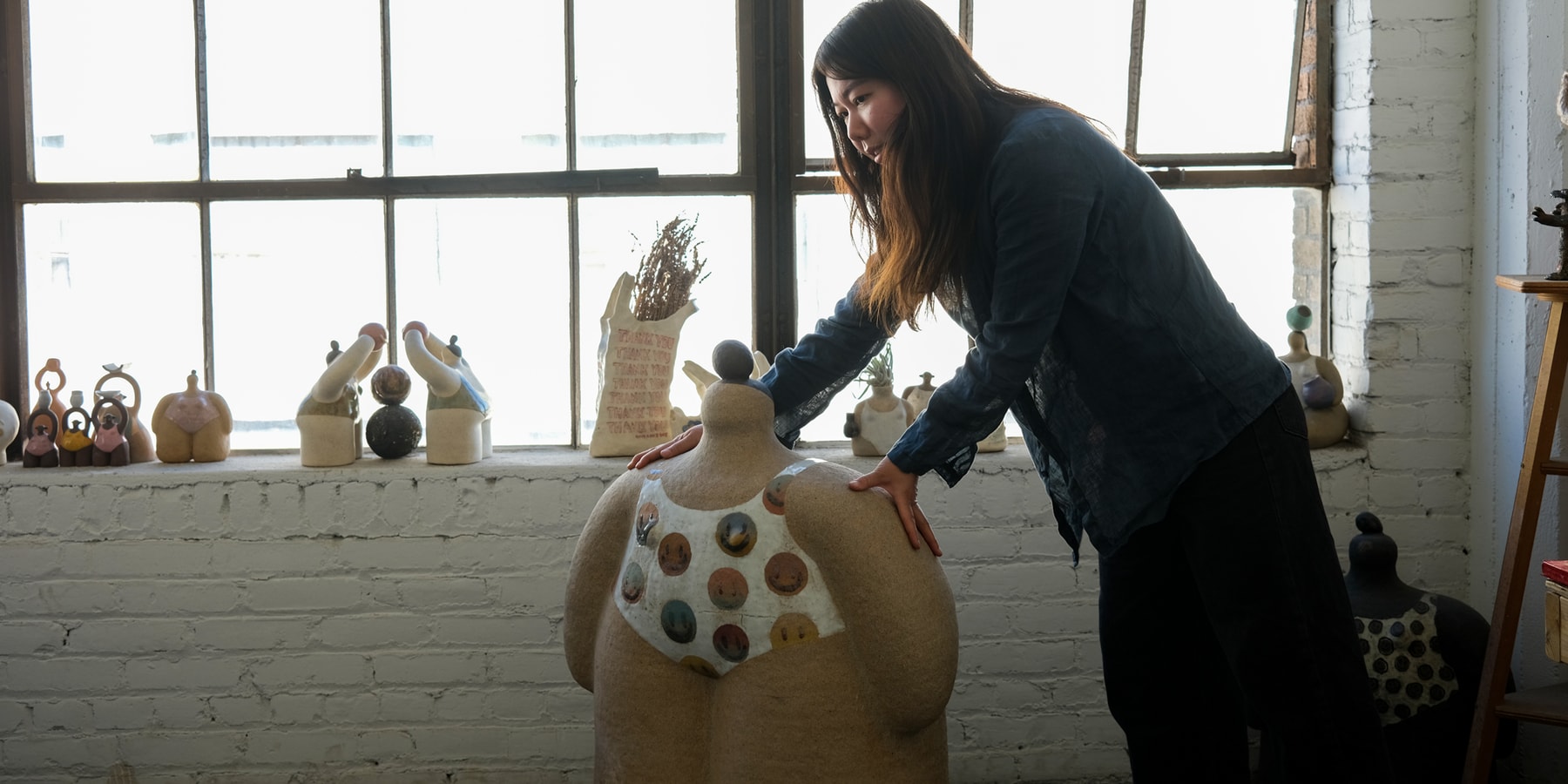
What do you hope people will understand when viewing your ceramics?
Overall, I just hope that my work makes them happy. That’s all I could ask for because I’m not an artist that’s trying to be so serious about issues or life or anything. Making these works make me happy, so that’s what I’m trying to achieve. For the next stage, though, I want to do something more on a personal level with an installation-type of presentation. So we’ll see how it goes.
Stay up to date on all of Taylor Lee’s projects by following her Instagram account here.
Photography by Shawn Ghassemitari and Keith Estiler








